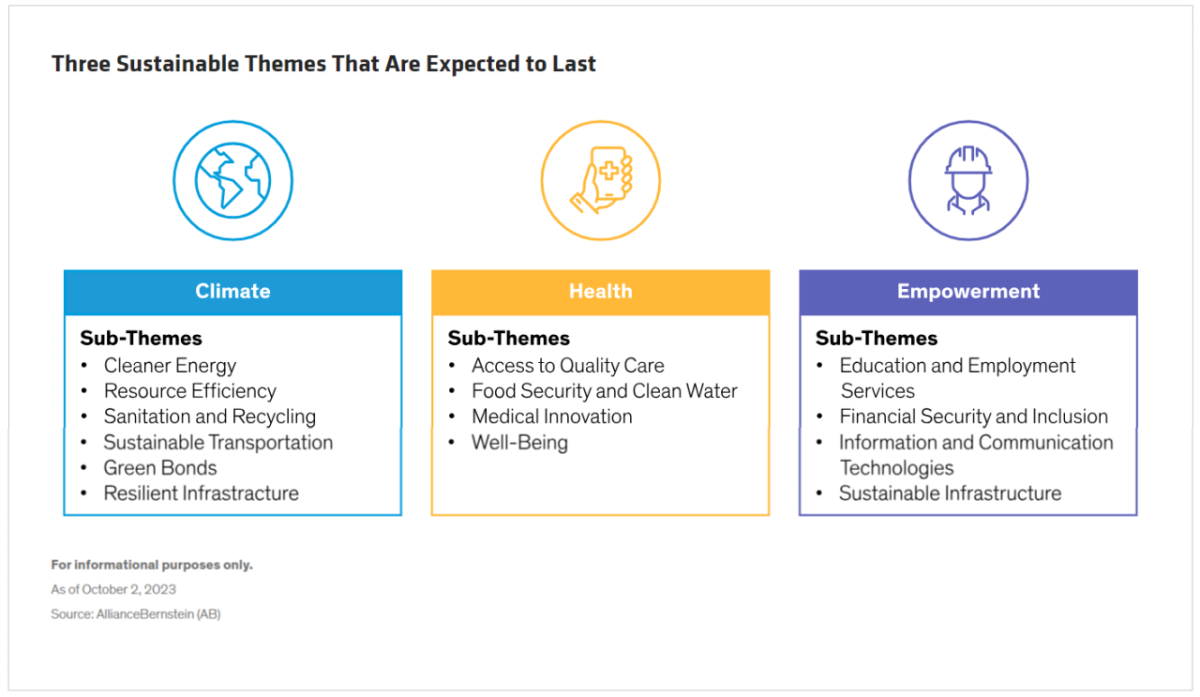AB: Seeking Balance in Sustainable Multi-Asset Investing
Published 11-08-23
Submitted by AllianceBernstein

David Hutchins, FIA| Portfolio Manager—Multi-Asset Solutions
Tiffanie Wong, CFA| Director—Fixed Income Responsible Investing Portfolio Management; Director—US Investment-Grade Credit
A multi-asset approach to sustainable investing brings a broad and more balanced palette to paint with.
Investors turn to sustainable strategies for attractive return potential and opportunities to align with environmental or social themes. For many, it means taking advantage of a broad range of sustainable investment types, from equities and fixed income to non-traditional alternatives, such as real estate and infrastructure.
Balance Can Help Make Sustainable Investing… Sustainable
We think the broader sustainable investment universe provides another potential benefit when effectively and consistently applied: balance.
When unconstrained, a multi-asset approach can leverage a wide mix of sustainable investment building blocks to pursue returns and dial up or down risk levels over time—both of which are important to investors who prefer fewer bumps in their ride.
The Journey Should Map to Global Sustainability Themes
The ideal starting point for prospective sustainable investments are companies whose operations are tied to some or all of the 17 United Nations Sustainable Development Goals (UN SDGs). So far, 193 nations have pledged to hit UN SDG targets, which address economic prosperity, the environment and social inclusion, and it’ll take about US$90 trillion in investments globally to do so by 2030.
These are powerful tailwinds for companies aligned with UN SDGs, and they represent a roadmap of thematic opportunities across stocks, bonds and other investments for years to come. We consider health, climate and empowerment among the most logical and compelling themes, given the breadth of each’s supportive sub-themes (Display).
More Levers, Less Volatility
Stocks have offered the most attractive long-term return potential compared to other assets, but they’re prone to short-term volatility and losses. Certainly, equities of all stripes (style, cap size, region, etc.) remain a key pillar in a sustainable portfolio, especially as more companies enter the ESG space and global opportunities expand.
US-based Hexcel, for instance, manufactures lightweight carbon fiber that displaces steel and aluminum in airplanes for better fuel efficiency—a boon to climate goals. Similarly, Adobe profitably empowers companies through its digital enterprise resources, leaving a very small carbon footprint in the process.
Similar alignments to global sustainability themes are also found in bonds, expanding the levers that multi-asset portfolios can use to make dynamic adjustments as markets shift. For example, the popularity of ESG-labeled bonds is exploding, with green bond issuance alone topping nearly US$4 trillion at year-end 2022, according to the World Bank.

Not All ESG-Labeled Bonds Are Alike
It’s important to understand how each ESG-labeled bond can uniquely contribute to a sustainable portfolio. They fall into two broad categories: use of proceeds, and sustainability linked.
Use-of-proceeds bonds finance specific green or social projects. Ørsted, for example, is a Danish energy provider targeting using 99% renewable sources by 2025. Proceeds from its green bonds will fund offshore wind farms and other renewables, conversion of gas and coal plants to sustainable biomass, and clean energy storage. Meanwhile, Scotland-based commercial bank NatWest Group’s social bond proceeds are aimed squarely at funding women-led enterprises.
Rather than financing individual projects, sustainability-linked bonds (SLBs) require that issuers meet specified sustainable key performance indicators within a specified timeframe—at the company level. For incentive, SLB frameworks can stipulate higher coupons if targets aren’t reached. Greece-based PPC, for instance, missed its 2022 year-end decarbonization target, and its coupon was stepped up 0.25% in March 2023 as a result.
Some ESG-labeled bonds may not have specific green or social targets for proceeds, but the issuer has set certain sustainability targets that it seeks to achieve. For instance, US Acute Care Solutions is a physician-owned provider of medicine, hospitals and observation services that strongly aligns with UN SDG health themes. The company is very employee-centric based on a “democratic ownership” model. Its in-network business model offers lower-than-average pricing compared to peers, and it takes measurable steps to ensure patient access to quality care while managing costs and fostering a diverse and inclusive workplace.
Talking Trash… and Trains and Tap Water
The diversification benefits of ESG-labeled bonds can go even further, considering the scope of issuers is much wider than companies, from non-profit agencies and provinces to sovereign nations.
Much like security selection, engagement* is a big part of the screening and integration process. Engagement entails meeting with issuers, reviewing their sustainability goals and even encouraging them to set more ambitious targets to attract investors.
AB regularly participates in early framing of an upcoming bond’s purpose and reach. For example, Canada’s finance department invited us to present our thoughts on a proposed seven-year ESG-labeled environmental bond in 2022, which at C$5 billion ranked it among the country’s largest and most sweeping. Bond proceeds were intended to finance nationwide biodiversity programs, cleaner transportation projects, wastewater management improvements, more renewable energy and other initiatives. AB has continued to engage with the Canadian government on topics such as green bond impact reports and future ESG-labeled bonds and frameworks.
Healthy Stretching: Alternative Assets Play a Role, Too
The traditional diversification benefits of stocks and bonds can’t always be relied on, as we saw in 2022. For this and other reasons, we think sustainable multi-asset investors should consider expanding, albeit selectively, into non-traditional assets, which are a growing part of the ESG world. Such alternatives today include digital infrastructure, such as power-saving smart buildings and renewable energy generation.
Regional exposure also matters, as does a variety of style (low volatility versus growth stocks) and low-correlating factors such as hedge fund premia and options. Integrating measured, complementary exposure among these outliers may especially help offset biases that can slowly creep up. This helps manage short-term volatility while enhancing diversification in issuers that contribute to positive environmental and social outcomes.
Sustainable multi-asset portfolio construction strives to combine the best opportunities across asset classes and the ESG universe. We believe the efficient integration of these ideas, including tactical maneuvers when conditions change, can help manage downside risk and provide a more balanced sustainable investing experience.
*AB engages companies where it believes the engagement is in the best interest of its clients.
The views expressed herein do not constitute research, investment advice or trade recommendations and do not necessarily represent the views of all AB portfolio-management teams. Views are subject to change over time.
Learn more about AB’s approach to responsibility here.

AllianceBernstein
AllianceBernstein
AllianceBernstein (AB) is a leading global investment management firm that offers diversified investment services to institutional investors, individuals, and private wealth clients in major world markets.
To be effective stewards of our clients’ assets, we strive to invest responsibly—assessing, engaging on and integrating material issues, including environmental, social and governance (ESG) considerations into most of our actively managed strategies (approximately 79% of AB’s actively managed assets under management as of December 31, 2024).
Our purpose—to pursue insight that unlocks opportunity—describes the ethos of our firm. Because we are an active investment manager, differentiated insights drive our ability to design innovative investment solutions and help our clients achieve their investment goals. We became a signatory to the Principles for Responsible Investment (PRI) in 2011. This began our journey to formalize our approach to identifying responsible ways to unlock opportunities for our clients through integrating material ESG factors throughout most of our actively managed equity and fixed-income client accounts, funds and strategies. Material ESG factors are important elements in forming insights and in presenting potential risks and opportunities that can affect the performance of the companies and issuers that we invest in and the portfolios that we build. AB also engages issuers when it believes the engagement is in the best financial interest of its clients.
Our values illustrate the behaviors and actions that create our strong culture and enable us to meet our clients' needs. Each value inspires us to be better:
- Invest in One Another: At AB, there’s no “one size fits all” and no mold to break. We celebrate idiosyncrasy and make sure everyone’s voice is heard. We seek and include talented people with diverse skills, abilities and backgrounds, who expand our thinking. A mosaic of perspectives makes us stronger, helping us to nurture enduring relationships and build actionable solutions.
- Strive for Distinctive Knowledge: Intellectual curiosity is in our DNA. We embrace challenging problems and ask tough questions. We don’t settle for easy answers when we seek to understand the world around us—and that’s what makes us better investors and partners to our colleagues and clients. We are independent thinkers who go where the research and data take us. And knowing more isn’t the end of the journey, it’s the start of a deeper conversation.
- Speak with Courage and Conviction: Collegial debate yields conviction, so we challenge one another to think differently. Working together enables us to see all sides of an issue. We stand firmly behind our ideas, and we recognize that the world is dynamic. To keep pace with an ever changing world and industry, we constantly reassess our views and share them with intellectual honesty. Above all, we strive to seek and speak truth to our colleagues, clients and others as a trusted voice of reason.
- Act with Integrity—Always: Although our firm is comprised of multiple businesses, disciplines and individuals, we’re united by our commitment to be strong stewards for our people and our clients. Our fiduciary duty and an ethical mind-set are fundamental to the decisions we make.
As of December 31, 2024, AB had $792B in assets under management, $555B of which were ESG-integrated. Additional information about AB may be found on our website, www.alliancebernstein.com.
Learn more about AB’s approach to responsibility here.
More from AllianceBernstein

